Max Ernst Biography
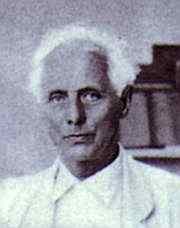
Max Ernst was born on 2 April 1891 in Brühl, near Cologne, the first son of Philipp Ernst, teacher of the deaf and amateur painter, and his wife, Luise, née Kopp. Max Ernst never received any formal artistic training. In 1910-1914 he studied philosophy and psychiatry at Bonn University and took a deep interest in painting.
In 1914 Ernst got acquainted with Jean (Hans) Arp, and their lifelong friendship began. With the outburst of the First World War Ernst was conscripted to the army, where he served in the field artillery till the end of the war, never dropping his interest in art. It was during the war, in 1916, when he took part in the "Sturm" exhibition in Berlin. To the same period date his first contacts with Dada artists.
After demobilization Ernst settled in Cologne, where, together with Johannes Theodor Baargeld, a pseudonym for Alfred Grünwald (1892-1927), he founded a group of Dadaists. Their exhibition of 1920 at the Winter Brewery in Cologne was closed by the police on the grounds of obscenity. The works of this period are mostly'junk' assemblages (e.g. Fruit of a Long Experience, 1919) and collages of printed matter. School text-books, educational placards and mail-order catalogs became his main source of materials. Cut-outs of different objects and patterns supplied by quotations come into absurd compositions, full of sarcasm. (e.g. The Hat Makes the Man. 1920; Dada-Gauguin, 1920, etc.)
In 1922, Max Ernst, following an invitation of his Dadaist friends, Gala and Paul Eluard, Tristan Tzara, André Breton, and others, moved to Paris. The same year he painted A Reunion of Friends, where he depicted himself and all his associates. In the paintings of his early Parisian period the artist was able to successfully combine the techniques of painting, assemblage and collage in large-scale paintings with enigmatic plots, e.g. Oedipus Rex, 1922; Teetering Woman, 1923; Two Children are Threatened by a Nightingale, 1924; etc.) In 1924 Ernst traveled to Indochina with Gala and Paul Eluard.
In 1924 André Breton published the First Surrealist Manifesto. Max Ernst was among those who shared the views and aims of the Surrealists and took an active part in founding the new movement. Ernst's invention of the frottage (pencil rubbings on paper or canvas) technique dates to the early 1920s. In this technique Ernst fulfilled a series of works, resulting in the publication of his famous "Histoire Naturelle". Frottage, which realizes the surrealistic principle of'psychological automatism', Ernst applied in painting as well, inventing the so-called grattage (scrapings), e.g. Eve, the Only One Left to Us, 1925.
In the late 1920s Ernst turned to the beloved motifs of German Romanticism and revived them in a new, Surrealistic, manner: dark forests, mysterious caves, gloomy cliffs, dead moonlight, figures and faces which appear like ghosts from interlacing branches and twigs. (Fishbone Forest, 1927, Hunter 1926, Vision Induced by the Nocturnal Aspect of the Porte St. Denis. 1927, Bird in a Forest, The Horde, 1927)
Between 1929 and 1939 in addition to large-sized pictures in the collage, frottage and grattage techniques, Ernst began producing books of collages, the best known are the collage-novels "La Femme 100 têtes" and "Une Semaine de bonté". It was in these books that the character with the strange name of "Loplop" appeared; Loplop took on the role of a narrator and commentator. As a pictorial image Loplop appeared in Ernst's works a little bit later, a bird-like fantasy creature, which represented the artist himself as his "private phantom", as Max Ernst himself once put it. The artist in the shape of Loplop appeared in his works in person, either in caption or pictorial form, throughout his life. (e.g. Loplop Introduces a Young Girl. 1930; Loplop Introduces Loplop, 1930; La Foresta Imbalsamata. 1935, The Angel of Hearth and Home, 1937, Surrealism and Painting. 1942, etc.) Thus The Angel of Hearth and Home was painted in response to the defeat of the Republican Spain and expresses his feeling of helplessness with regard to the coming menace of fascism.
In 1937 Ernst distanced himself from Breton and the Communist group of Surrealists, though he remained true to the chosen methods of work. In 1938 he left Paris and settled in Saint Martin d'Ardèche in the South of France, where his famous picture The Robing of the Bride was painted.
With the outbreak of the Second World War Max Ernst was arrested by French authorities for being a "hostile alien". Thanks to the intercession of Eluard, he was discharged a few weeks later. Soon after the French occupation by the Nazis, he was arrested by the Gestapo, managed to escape and flee to America with the help of Peggy Guggenheim, a sponsor of the arts.
In 1941-1945 Ernst lived in NY, where together with other European emigrant painters, he not only worked but also shared his knowledge and experience with younger American colleagues, thus leaving a lasting and profound influence on the development of American modern art. The pictures of the period Europe After the Rain II, 1940-42, Day and Night, 41/42, The Eye of Silence, 43/44; Vox Angelica, 1945; The Temptation of St. Anthony, 1945, etc., reflect in a surrealistic manner the tragic social reality.
In 1946-52 Ernst lived in Arizona, surrounded by landscapes that resembled his own pictorial phantasmagorias. In the USA he got interested in sculpture and left a number of pieces, which mainly consisted of found objects assembled in ever-new combinations.
In 1953 the artist returned to Europe and settled in France. In the 1950s Ernst got world acclaim. In his late works the artist returned to the subjects of his early, Dada period, e.g. A Virgin, A Widow and a Wife, 1946; Colorado of Medusa, Color-Raft of Medusa, etc.
Max Ernst died on 1st April 1976 in Paris, one day before his 85th birthday.
Bibliography
Max Ernst. By P. Waldberg. Paris. 1958.
Max Ernst. Life and Work. By J. Russel. London. 1967.
Max Ernst. By E. Quinn. London. 1977.
Max Ernst. Beyond Painting. By Ulrich Bischoff. Benedict Taschen Verlag. 1987.
Max Ernst and Alchemy: A Magician in Search of Myth (Surrealist) by M. E. Warlick, Franklin Rosemont. Univ of Texas Pr, 2001.
Max Ernst by Edward Quinn. Konemann, 1999.
Marcel Duchamp and Max Ernst: The Bride Shared (Clarendon Studies in the History of Art) by David Hopkins. Clarendon Pr, 1998.
Ernst (Colour Library) by Ian Turpin. Phaidon Press Inc., 1993.
Ernst: Pieta or Revolution by Night (Tate Modern Masterpieces) by Malcom Gee. Tate Gallery Pubn, 1986.
- Fruit Of A Long Experience.
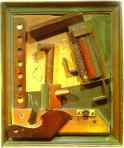
1919. Painted wood relief. 45.7 x 38 cm. Private collection.
- A Friends' Reunion/Au Rendez-Vous Des Amis.
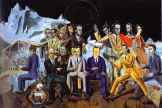
1922. Oil on canvas. 130 x 95. Museum Ludwig, Cologne, Germany. Read Note.
- Oedipus Rex.
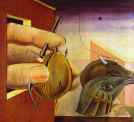
1922. Oil on canvas. 93 x 102 cm. Private collection.
- The Equivocal Woman (Also Known As The Teetering Woman).
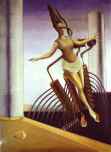
1923. Oil on canvas. 130.5 x 97. 5 cm. Kunstsammlung Nordrhein-Westfalen, Düsseldorf, Germany.
- Two Children Are Threatened By A Nightingale.
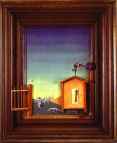
1924. Oil on wood with wooden elements. 69.8 x 57.1 x 11.4 cm. The Museum of Modern Arts, New York, NY, USA.
- Eve, The Only One Left To Us.
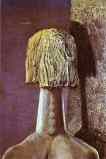
1925. Oil on plaster on cardboard. 50 x 35 cm. Private collection.
- Fishbone Forest.
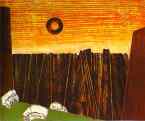
1927. Oil on canvas. 54 x 65 cm. Private collection.